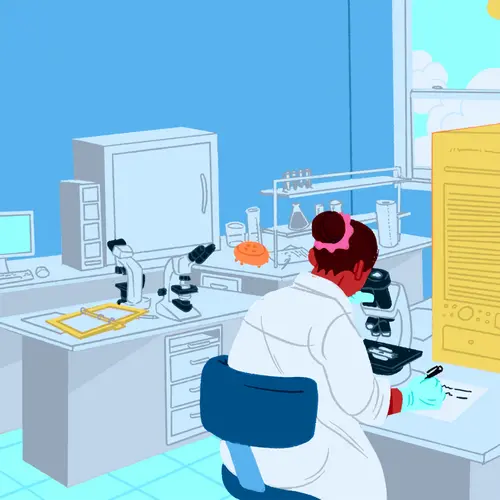Not all scientific breakthroughs start with a big idea. Sometimes, it’s just a matter of being in the right place at the right time and asking the right questions.
When MIT scientist Phillip Sharp, PhD, began to study the structure of something called adenoviruses -- they cause the sniffles and sneezes of the common cold -- he never thought he would completely change how we understand our genes, those tiny bits of human code that are made up of DNA.
Genes have fascinated scientists ever since Gregor Mendel spent years puttering in a garden growing sweet peas in the 19th century. That gardening, and Mendel’s relentless record-keeping of what he learned through it, gave insight into what we inherit -- in people those are traits like curly hair or blue eyes that we get from our parents.
It also led to the understanding that our genes act as a kind of cookbook, providing the recipes to make proteins, all of which help our bodies work.
Although we’ve learned a lot about our genes in the past 200 years, modern scientists still have many questions.
The Shape of Things to Come
In the 1960s and ’70s, when Sharp was a young researcher, science was primed for new breakthroughs in genetics. And with a PhD in chemistry, Sharp wanted to explore genes himself. So he dove in.
What came next was a breakthrough moment.
When a gene is activated, or “turned on,” all the information it contains gets turned into a protein, which does a specific job. The thought at the time was that all genes, including those of so-called higher organisms -- like those of human beings -- looked and acted this way.
That thinking was about to change.
A Sniffle Starts a Revolution
The gene structure of humans was something Sharp wanted answers about for years.
He decided to focus on the sneeze-causing adenovirus, which, because of its simple structure, was ideal for study. Sharp wanted to know where different genes were located in it. He believed this could give scientists more information about evolution.
Experts were convinced that more knowledge about how genetics evolved could answer any number of medical questions.
Sharp wasn’t alone. Richard Roberts, PhD, was also researching genetics at Cold Spring Harbor Laboratory in Long Island, a private research organization. When they joined forces, that tag-team literally changed the world.
‘We Knew the Textbooks Were Going to Have to Change’
In a series of experiments in the late 1970s, Sharp and Roberts showed that not all the code in adenovirus genes is useful. Some is just there, taking up space without a real purpose. It has come to be called “junk DNA.” In describing the presence of these two kinds of code, scientists said the genes were “split.”
“We knew the textbooks were going to have to change since it was a game-changing insight into biology,” laughs Sharp, institute professor at MIT. “But we didn’t quite know what was going to happen next.”
That turned out to be the discovery of another entire genetic process. Sharp and Roberts learned that the body deletes the “junk DNA.” What’s left behind gets combined -- or spliced together -- to give your cells the information they need to do their job.
A biological cut-and-paste, if you will.
But how does this knowledge help fight diseases? That answer was still a few years away.
The Power of Splicing
When splicing was discovered, nobody could quite understand the process. Scientists needed to figure out a way to reproduce it in a lab so they could study it more closely.
That’s when a young undergrad at Columbia University went to work.
“I became fascinated with it since it was the frontier,” says Adrian Krainer, PhD.
It took 7 years, but Krainer figured out a way to repeat the process in a lab. Now, as a result of his work, we know that some hereditary diseases are related to problems in the splicing process. The best example is thalassemia, a type of anemia. A gene therapy for it is being tested now.
His reward for this discovery? A job with Roberts at Cold Spring Harbor, where Krainer has been ever since.
“Rich Roberts was my mentor,” says Krainer, now St. Giles Foundation professor of molecular genetics at Cold Spring Harbor.
Krainer’s focus these days is a devastating disease called spinal muscular atrophy, or SMA. It affects the nerves that control muscles and movement. The disease is believed to be caused by, yes, gene-splicing problems.
Early studies have been promising, and now Krainer and other researchers are testing a drug that could correct those problems.
“Adrian [Krainer] has been a major leader in the science as well as the translation of that science for the possible treatment … for this horrible disease,” Sharp says.
“It is humbling and rewarding to know that the work we started continues this way.”
It’s Far From Over
In 1993, Sharp and Roberts received the Nobel Prize in Physiology or Medicine for their findings on split genes.
“We are doing things today that weren’t even possible in 1977,” says Sharp, who co-founded biotechnology firm Biogen (now called Biogen Idec) and early stage therapeutics company Alnylam Pharmaceuticals. “And the only way we won’t make progress is if we turn against progress and accept the status quo. I don’t think that will ever happen.”
Sharp is pretty convinced that if he and Roberts didn’t discover split genes in 1977, some other labs would have rather quickly.
“The field was ready for the discovery,” he laughs. “Within months of our finding, everywhere I went people knew about it, but they were telling me about other genes that were segmented and then expressed by RNA splicing.
“I felt a little obsolete, but that’s the nature of science. It’s always moving forward.”

